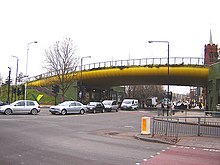This is an old revision of this page, as edited by Choess (talk | contribs) at 05:50, 28 April 2006 (→Peasants' Revolt: dab). The present address (URL) is a permanent link to this revision, which may differ significantly from the current revision.
Revision as of 05:50, 28 April 2006 by Choess (talk | contribs) (→Peasants' Revolt: dab)(diff) ← Previous revision | Latest revision (diff) | Newer revision → (diff)Template:Infobox London place Mile End is an area of the London Borough of Tower Hamlets in East London. Mile End is 3.6 miles (5.8 km) east north-east of Charing Cross.
It takes its name from a milestone signifying the point one mile east of the boundary of the City of London. Although historically the stone's position was near Stepney Green tube station, in the modern era Mile End is used to describe the area about half a mile east of this point, around Mile End tube station.
Mile End is in a part of London known as the East End and home to the main campus of Queen Mary, University of London.

It also boasts an unusual landmark, the "Green Bridge". This new structure (completed in about 2000) allows Mile End Park to cross over the road and makes an interesting contrast with the more usual approach of building bridges for cars. It contains garden and water features and some shops and restaurant space built in below.
Mile End as a London constituency sent a Communist MP to the House Of Commons after 1945 Phil Pirratin. At that time it had a large Jewish poulation. The area now is covered by the Bethnal Green and Bow seat which has returned to its left-wing roots with the election of Respect Unity MP George Galloway.
Peasants' Revolt
In 1381, an uprising against the tax collectors of Brentwood quickly spread first to the surrounding villages, then throughout the South-East of England but it was the rebels of Essex led by a priest named Jack Straw, and the men of Kent led by Wat Tyler who marched on London. On the 12th June, the Essex rebels, 60,000 men, camped at Mile End and on the following day the men of Kent arrived at Blackheath. On the 14th June, the young king Richard II rode to Mile End where he met the rebels and signed their charter. Unfortunately, their subsequent behaviour caused the king to have the leaders and many rebels executed.
Second World War

Besides suffering heavily in earlier blitzes, Mile End was hit by the first V-1 to strike London. On 13 June 1944, this 'doodlebug' impacted next to the railway bridge on Grove Road, an event now commemorated by a plaque.
Nearest places
Transport